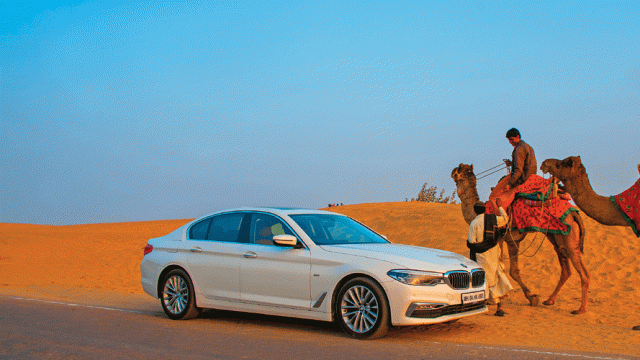Like aged wine, Delhi becomes more graceful, more valuable and more alluring with every passing

THINGS TO SEE AND DO:
Most of Delhi’s tourist sites are spread over three broad areas – Central Delhi, the seat of govern-ment; Old Delhi, which has managed to keep its vibrant, unique past alive; and South Delhi, the realm of posh residential areas, markets and malls
CENTRAL DELHI
Between 1911 and 1931, India’s Colonial rulers aimed to create a new capital district in the heart of Delhi that would symbolise their power. The area was developed to a design by British architect Edwin Lutyens. To this day, the awe-inspiring Rashtrapati Bhavan atop Raisina Hill, looking down the Rajpath, remains a glorious emblem of India’s sovereignity. Post independence, the grand buildings, spacious vistas and tree-lined boulevards of Lutyens’ Delhi became the abode of the political and bureaucratic elite and evolved as the power centre. This is, arguably, the greenest, cleanest and most attractive part of the city.
Rashtrapati Bhawan
This phenomenal structure was designed by Edwin Lutyens and Herbert Baker, with the aid of a town planning committee. While the building is closed to the public, the architects’ attempts to integrate Indian features in the design are evident in the façade. Nearby, the two Secretariat buildings, called North and South Block, are built on a platform. Behind the buildings are Mughal Gardens.
India Gate
Down the road from the gates of the Rashtrapati Bhavan, Rajpath culminates at India Gate. This statly monument commemorates the Indian soldiers killed in World War I. Today, the green lawns surrounding the arch are a popular communal space for citizens, who come here during breezy summer eveningsor sunny winter mornings to have a picnic.

Janpath and Connaught Place
The erstwhile Queen’s Way is now called Janpath. This long road sweeps past ministerial residences, the National Museum and luxury hotels, and leads to its namesake market, famous for boutique stores and pavement stalls. Nearby is Connaught Place, Delhi’s premier shopping district. Designed in typical English fashion by Robert Tor Russell in 1913–31, it is an arcade boasting retail stores, restaurants and other commercial establishments.
Jantar Mantar
This 18th-century observatory on Parliament Street was built by Maharaja Jai Singh II of Jaipur (1699–1743). It comprises six instruments, of which the largest is the Samrat Yantra, a sundial.

Purana Qila
Believed to be the oldest amongst the city’s monuments, Purana Qila’s foundations were laid by Humayun, the second Mughal Emperor. However, the Afghan leader Sher Shah Suri expanded the complex by adding more buildings, the ruins of which can be seen today. Don’t miss the Sher Mandal, a two-storeyed octagonal building, and the grand Qila Kuhna Mosque. A sound and light show is held here in the evenings.
Entry Indians ₹20; Foreigners ₹200
Humayun’s Tomb
A UNESCO World Heritage Site, Humayun’s Tomb (1565-66) is the first of the famous garden tombs of the Mughals. The main building, its water channels, fountains and gardens have all been beautifully restored today.
Entry Indians ₹30; Foreigners ₹50

Lodhi Gardens
Delhi Sultanate’s lesser-known Sayyid and Lodhi dynasties built the little architectural gems around which these gardens were planned. Landscaped in 1968 by Joseph Allen Stein, today they are a jogger’s delight and picnicker’s haven. Check out the 15th-century Bara Gumbad, the Shish Gumbad and the tomb of Sikander Lodhi.
Safdarjung’s Tomb
This is the tomb of the viceroy of Awadh, Mirza Muqim Abul Mansoor Khan, built by his son Shuja-ud-Daulah in 1758. It’s unmistakably built in the architectural tradition of the Taj – onion dome, garden et al.
OLD DELHI
‘Shahjahanabad’, as this area was once called, was established in 1648 by the fifth Mughal, Shah Jahan. It was a hub of politics, culture, poetry and arts, trade, and the sheer pursuit of leisure. After the revolt in 1857, the old city was largely destroyed by the British.
Red Fort
Among the Mughal city’s best preserved monuments are the Red Fort (Lal Qila), complex, named after the red sandstone from which it is built, and the ethereal Jama Masjid. The Red Fort, in particular, makes visitors reel under the cumulative impact of marble, pietra dura, gilded pillars and delicate carvings. Not to be missed are the red sandstone Diwan-i-Aam with its painted marble canopy; the Khas Mahal and its intricate lattice screen, the adjacent Diwan-i-Khas; the Shah Burj and the Moti Masjid, named for the lustre of its marble.
Entry Indians ₹351; Foreigners ₹500 Closed Monday
Jama Masjid
Mughal emperor ShahJahan’s Jama Masjid is one of the finest examples of the three-domed Mughal mosque. A few relics of Prophet Muhammad, including a hair from his beard, his sandals and his footprint in marble, are preserved in a pavilion of the Jama Masjid, along with two copies of the Quran.
Entry Free Timings 7.00am– 12.00pm & 1.30–6.30pm (no entry for non-Muslims at prayer times) Minaret entry Indians ₹10; Foreigners ₹100

SOUTH DELHI
Qutub Complex
In 1192, the defeat of Rajput king Prithviraj Chauhan at the hands of Muhammad Ghori ushered in ‘Islamic rule’ in India. Ghori made Turkish slave-promoted-to-general Qutubuddin Aibak the steward of Delhi, beginning the ‘Slave Dynasty’. Local Hindu and Jain temples were dismantled to make way for the Quwwat ul Islam Mosque, with intricately carved pillars, and a west-facing prayer hall.
The star attraction of the complex, however, is the Qutub Minar (1200–1210), the construction of which was started by Aibak and completed by Iltutmish, his son-in-law. This 73-m-high sandstone and marble tower is a UNESCO World Heritage Site.
Iltutmish’s tomb and madrasa, built by the king himself in 1235, is a deceptively simple building, with Quranic injunctions on all sides. Allauddin Khilji built the Alai Darwaza (1311), on the southern side of the Quwwat ul Islam mosque. The rust-free Iron Pillar of Mehrauli that stands in the courtyard is a 5th-century relic that bears an inscription eulogising the Guptas.
Entry Indians ₹30; Foreigners ₹500; Children (below 15) Free Timings Sunrise–sunset

Tughlaqabad Fort
The Tughlaqabad Fort (circa 1320), built by King Ghiyasuddin Tughlaq, is a vast stonescape hugging a rocky spread. Scramble up on the grassy hillocks of the fort to admire the views. The tomb of Ghiyasuddin (1325), is just opposite the main gate of the fort.
Hauz Khas Complex
Hauz Khas is a pleasant enclave of pillared verandahs that once served as madarsas. The tomb of Firoz Shah Tughlaq (1352) is also located here. These buildings are arranged in an L-shape around a hauz (water tank), built by Allauddin Khilji in 1300. Hauz Khas cuts a pretty picture, especially since the area has been developed as a quirky, bohemian
space in recent years, boasting boutiques, art galleries and cafés.
Museums
Most of Delhi’s museums are unmissable. Amongst them, the National Museum (Entry: Indians ₹20, Foreigners ₹650; Timings: 10.00am–5.00pm; Tel: 23792775/ 23019272) at Janpath enjoys the pride-of-place. Its collection spans over five millennia, from Harappan sculptures to Mughal miniatures. The National Gallery of Modern Art (Entry: Indians ₹20, Foreigners ₹150; Timings: 10.00am–5.00pm; Tel: 23384640/ 2835) at India Gate has contemporary paintings, sculpture and graphic art.
PLACES OF WORSHIP
The Jama Masjid, built between 1650 and 1656, is the most revered mosque in the city. The Dargah of Nizamuddin Auliya is the final resting place of the Sufi saint and his disciple, poet Amir Khusrau. It was built in the 14th century.
The Baha’i House of Worship, also known as Lotus Temple, is a beautiful structure that resembles a lotus. It attracts numerous visitors.
Amongst famous Sikh temples is the Bangla Sahib Gurudwara, where Guru Har Kishan, the 8th guru of Sikhism, lived when he visited Delhi in 1664.
Several British-era churches evoke Delhi’s Colonial past. St James’ Church (1836) at Kashmere Gate is the oldest church in the city.

WHERE TO STAY
Luxury hotels
The Taj Mahal (Tel: 011-23026162, 66566162; Tariff: ₹15,900–5,00,000 approx) is a favourite for its highly personalised services, luxurious rooms and good restaurants. The Oberoi (Tel: 24363030) a leisure-and-business hotel, is much favoured by globetrotting executives. It was under renovation at the time of research. The Imperial (Tel: 41501234; Tariff: ₹22,500–2,00,000) is elegant heritage hotel with an atmospheric old wing and beautifully refurbished public areas. ITC Maurya (Tel: 26112233; Tariff: On request) overlooks the greenery of the Delhi Ridge and is celebrated for its Bukhara restaurant.
The Lodhi (Tel: 43633333; Tariff: ₹20,000–70,000) is stylish, elegant and unique in its understated aesthetics. The Park (Tel: 23743000; Tariff: ₹7,000–20,000), India’s first boutique hotel, offers a slew of award-winning restaurants with delectable dishes.
The Roseate (Tel: 33552211; Tariff: ₹14,500–30,000) is an outstanding property with water bodies and verdant premises.
Mid-range hotels
Vivanta by Taj – Ambassador (Tel: 6626100; Tariff: ₹10,000–27,000 approx) is located close to Khan Market and Lodhi Gardens. Jukaso Inn (Tel: 24350308-09; Tariff: ₹5,000–6,000), situated in one of Delhi’s top residential areas, is a modern, friendly establishment. Shervani (Tel: 42501000; Tariff: ₹5,000–6,500) offers good rooms with modern amenities.
Budget options
Ginger New Delhi (Tel: 66633333; Tariff: ₹1,905–2,326) is a neat, value-for-money hotel near New Delhi Railway Station. In the Paharganj area, trustworthy establishments include Grand Godwin (Cell: 08860081991; Tariff: ₹2,000–2,500), behind Sheila Cinema, and Metropolis Tourist Home (Tel: 23561794, 23561782/ 94, 23585492; Tariff: ₹2,000–3,500) near Imperial Cinema. Hotel Namaskar (Tel: 23583456/ 2233; Tariff: ₹400–700) is near New Delhi Railway Station.
Bed-and-breakfasts
Some of Delhi’s better-known B&Bs include Amarya Villa (Tel: 4103 6184; Tariff: ₹4,900–10,000) in south Delhi, with good home-cooked meals, B Nineteen (Tel: 41825500; Tariff: ₹9,000) with Humayun’s Tomb as its backdrop and Eleven (Tel: 24351225, Cell: 09811088966; Tariff: ₹5,500) in a Nizamuddin house with a lush lawn.
WHERE TO EAT
Central Delhi
The N-Block in Connaught Place is a hub for restaurants. Try Berco’s for an Indo-Chinese meal, Nizam’s Kathi Kababs for non-vegetarian rolls, Nirula’s Pot Pourri for the salad bar buffet, Wenger’s for bakery items, patties and kebabs and the old fashioned United Coffee House and Embassy for good solid food.
Khan Market has restaurants such as Big Chill, Market Café, Town Hall, Smokey’s and Perch, all offering great ambience and music with great food.
Old Delhi
Karim’s near Jama Masjid is a non-vegetarian’s paradise, from the basmati badam pasanda to the mutton burra. In addition, the dhabas of Paranthewali Gali are famous for their deep fried, stuffed food. Methi, rabri, matar, banana: you name it, they’ve got it.
South Delhi
Olive Bar and Kitchen, near Qutub Minar, boasts great Mediterranean cuisine. Diva in Greater Kailash II, is the best fine dining Italian restaurant in Delhi. Oh! Calcutta in Nehru Place serves unforgettable kankra chingri bhapa and smoked hilsa, while Swagath in Defence Colony has excellent Chettinad dishes and seafood. TGI Friday offers fabulous pork ribs and good Tex-Mex dishes
FAST FACTS
When to go Delhi is a furnace from mid-April to July. Between July and October, visit if you don’t mind the humid heat caused by the monsoon. It can get quite cold in December and January, an excellent time to enjoy soft sunlight on broken columns and soul-warming roasted sweet potatoes on the streets. But from October to November (autumn) and February to March (spring) – Delhi is perfect
Tourist Office
Delhi Tourism Development Corp, Coffee House, Baba Kharak Singh Marg, New Delhi Tel: 011-23365358
W delhitourism.gov.in
STD code 011
GETTING THERE
Air Delhi’s Indira Gandhi International Airport is linked to most domestic airports in the country. Pre-paid taxi stands and radio taxis are available at both terminals, domestic and international
Rail Delhi is served by Old Delhi, New Delhi, Hazrat Nizamuddin, Sarai Rohilla and Delhi Cantonment stations, which boast the best rail connections
Road Delhi is served by AH1 from Kolkata via Bardhaman, Varanasi, Allahabad, Kanpur and Agra; NH48 from Mumbai via Surat, Ahmedabad, Udaipur, Ajmer and Jaipur; AH1 from Amritsar via Jalandhar, Ludhiana and Ambala; and the Agra-Lucknow Expressway and the Yamuna Expressway/ NH19 from Lucknow
Read more in the new Outlook Traveller Getaways Heritage Holidays in India
Jama Masjid
history
India Gate





